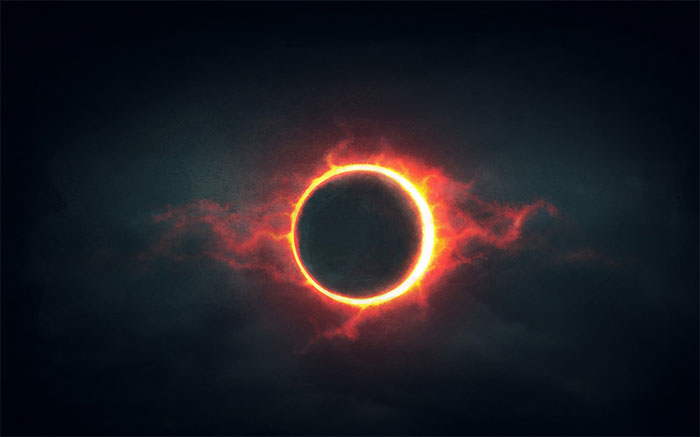Vietnam is about to admire the beautiful annular eclipse, 11 years later to meet again
In 2020, the beginning of the new decade with the world is not really smooth when the arrival of the Covid-19 pandemic. But for the astronomy community, they will be somewhat comforted because this will be a year with many interesting astronomical phenomena happening.
Coming here, at 10:45 am on June 21, if you look out the window, you will see a ring of glowing fire appear in the middle of the sky. It is the annular eclipse - the first eclipse of the year 2020.
The annular eclipse will extend from Central Africa, cross the Arabian Peninsula, India, China and reach the Pacific Ocean. According to Space.com, this eclipse will begin at 10:45 am on June 21, meaning that in Vietnam we can also observe.

Annular eclipse - the first eclipse of the year 2020.
What is the annular eclipse?
A solar eclipse is the phenomenon of the Moon blocking between the Sun and the Earth, forming a shadow that imprints on some of our areas. However, the problem is that the Earth and Moon's orbit are both elliptical, so the distance to the Sun is not always the same.
In the case of the Earth near the Sun, while the Moon is far from Earth, the moon will not be able to cover the Sun but leave a bright edge in the shape of a ring - the annular eclipse .
Time to observe solar eclipse
In Hanoi , partial eclipses begin at 13:16, peaking at 14:55 with a coverage rate of 71%, ending at 16:18. In Da Nang , partial eclipses begin at 13:30, reaching a peak at 15:04 with a coverage rate of 56%. In Ho Chi Minh City starting at 13:37, peaking at 15:05 with a coverage rate of only 36%, ending at 16:18.

In Hanoi, partial eclipse begins at 13:16, reaching a peak at 14:55.
After this eclipse, Vietnamese people have to wait until 2023 to observe this amazing astronomical phenomenon. However, the solar eclipse of 20/4/2023 is almost negligible when in our country the sun is only obscured up to 5%.
Two partial solar eclipses in 2027 and 2028 were also not noticeable because of very low coverage rates, reaching only 15% and 30% respectively.
It was not until 2031 that we saw another interesting solar eclipse when there were places in Vietnam that observed coverage of up to 80%.
Therefore, this is a great opportunity for those who want to admire this interesting astronomical phenomenon.
What to prepare for the eclipse?
Even if the Sun is completely covered, you should not look directly at the eclipse, because just a single ray of light is enough to damage your retina.
Sunlight can trigger chemical reactions behind the eyeball, allowing you to perceive the image. But in the case of too much light, the chemical reaction becomes very strong, which exceeds the tolerance of the retina and causes eye damage.

Eye damage due to direct exposure to the sun.
As a result of this process, your eyes will be in severe pain, temporarily unable to see clearly the surrounding object, and lose the ability to perceive color details. Even if the reaction is too strong, there will be permanent blind spots in the retina. In mild cases, visual defects can last for months, even years.
So what to do if you want to watch the eclipse? The simplest way is to equip solar glasses (solar glasses) - capable of completely filtering out, only retaining 0.003% of light from the Sun alone.
If you want to take photos, record eclipse movies, or view with a telescope, you need an extra layer of light filter to block out solar radiation.
- Sino-Japanese-Americans will witness an eclipse of the annals
- Admire partial eclipse across Asia
- Watch the annular eclipse
- A guide to observing the solar eclipse of the day on May 21
- Vietnam will watch an annular solar eclipse on May 21
- Vietnam did not observe the first solar eclipse of the year
- See eclipse images taken from satellites
- Eclipse was once considered a sign of evil
- The world welcomes the sun's ring, the moon in the middle of the year 2017
- In 2013, twice admired the lunar eclipse
- The world sees annular eclipse
- Tomorrow Vietnam will receive a solar eclipse
 Van Allen's belt and evidence that the Apollo 11 mission to the Moon was myth
Van Allen's belt and evidence that the Apollo 11 mission to the Moon was myth The levels of civilization in the universe (Kardashev scale)
The levels of civilization in the universe (Kardashev scale) Today Mars, the sun and the Earth are aligned
Today Mars, the sun and the Earth are aligned The Amazon owner announced a secret plan to build a space base for thousands of people
The Amazon owner announced a secret plan to build a space base for thousands of people